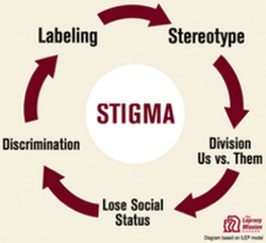Written by Hannah Clayton, Honorary Research Assistant, CARMS Project
The CARMS (Cognitive AppRoaches to coMbatting Suicidality) Project aims to understand suicidal experiences while implementing a new psychological therapy to reduce suicidal experiences in people with psychosis. In the last CARMS blog, we spoke about debunking myths around suicidality. We thought it was also important to share why people still believe in these myths, why these beliefs could be stopping people from talking about suicide and what we all could do to help end the stigma surrounding talking about suicide.
Speaking about suicidal experiences is a central part of the new therapy, which was designed by a team of suicide prevention researchers, clinicians and experts by experience at the University of Manchester. This means it is important to recognise the factors stopping people from openly talking about suicidal experiences. One main factor may be the stigma attached to both suicide and mental health problems.
What is stigma?
Stigma is generally defined as a mark of disgrace, which sets an individual apart from others[1]. This can come in many different forms including public stigma, which is the discriminatory set of beliefs held by general society, consisting of labelling and stereotyping certain groups of individuals[2]. For example, one commonly held public belief is that people with mental health problems are violent and unpredictable, even though this stereotype has since been shown to be false[3]. Another form is self-stigma, when individuals internalise, or adopt, the negative attitudes of society[4]. For example, individuals with mental health problems may begin to believe they are violent and unpredictable themselves, leading to self-isolation and/or self-discrimination[5].
Stigma surrounding mental health and suicide is widespread in Western society. It often leads to people distrusting, shunning or avoiding those who have been affected by suicide[6]. One reason for this is that suicide used to be a crime in the UK and is still viewed as a crime in some cultures, meaning it is still associated with wrongdoing. This is reflected in the language we use to talk about suicide today, as the phrase “to commit suicide” equates it with other criminal acts[7]. The myths around suicide, which we spoke about in our last blog, also contribute to this ongoing stigma, as people who experience suicidal feelings or acts may still be seen as ‘selfish’ or ‘attention seekers.’ Yet it is important to remember that anyone who has suicidal experiences deserves genuine help and are not selfish.
Effects of stigma
Stigma attached to mental health problems and suicide can affect individuals in many different ways. Some consequences of stigma may be:
- A reduction in self-esteem and self-worth[8]
- Hopelessness and shame[9]
- Social isolation and impaired social networks[10]
- Unemployment and/or discrimination when applying for jobs[11]
- Bullying, harassment and physical violence[12]
These consequences may then worsen individuals’ mental health problems and increase their risk to suicidal experiences[13]. This may also delay or impede help-seeking and support for these problems, as well as finding ways to cope and manage their suicidal experiences and mental health problems.[14]
Factors contributing to Stigma
There are arguably many different factors which have been creating and maintaining public stigma beliefs around suicide. These include:
- The Media: There are often negative portrayals of people with mental health problems who have suicidal experiences in the media. Sometimes mental health is wrongly sensationalised, while other times those with mental health problems are portrayed as violent and dangerous[15]. For example, reports of suicide deaths are often criticised for being insensitive or harmful[16], and these negative depictions of suicide have even been found to increase suicidal behaviour[17].
- Gender: In the UK, men are 3 times more likely to take their own lives[18]. This may be partly due to the increased stigma men face around seeking help more generally and speaking about suicide. Traditional masculine norms, such as the suppression of emotion, may contribute to this gender difference in stigma[19]. Additionally, there is also a lot of hostility towards people who are gender non-binary, gender questioning and transgender, putting them more at risk of mental health problems[20]. Sexual orientation is another related factor which may also increase the risk of mental health problems and suicidal experiences[21]. (Further information and support for people who identify with these groups can be found on the Stonewall, Gendered Intelligence, Proud Trust and Mermaids websites).
- Language: As we have already mentioned, the language we use around suicide may also add to stigma. Language may stereotype, alienate or even glamorise individuals who have had suicidal experiences. Phrases which may do this include: “commit suicide,” “unsuccessful/successful suicide” and “suicide epidemic”[22].
Issues of how we speak about suicide, how suicide is portrayed in the media and the pressure of gender norms all may contribute to someone feeling like they are not able to talk about their suicidal experiences.
How to help end stigma surrounding suicide
It may seem hard to change these negative attitudes around mental health and suicide, but there are some small steps we can each take to help reduce stigma. Here are a few examples:
- Support a friend, colleague or relative who may be experiencing a mental health problem and/or suicidal experiences. (See the Time to Change website and the Samaritans website for more information and guidance on providing your support)
- Be mindful of the language you use when talking about mental health and suicide. For example, try to avoid the phrase “committed suicide” and instead use expressions like “took their own life.” (See more pointers and information on the Mental Health Foundation website)
- If reporting suicidal experiences in a media or academic outlet, then ensure Samaritans suicide reporting guidelines are used.
- Get involved with charities like Time to Change, Mind and Samaritans who are fighting to end the stigma around mental health problems and supporting people currently dealing with mental health problems and suicidal experiences.
- There are also ways to deal with stigma if you are facing this yourself. The Mind website provide more information on how best to do this.
If you would like more information about the CARMS Project please contact Charlotte Huggett by telephone: 0161 2710729.
* This article contains references to suicide that some people may find distressing so if at any point you require urgent support with your mental health please contact your GP, care coordinator or crisis team. Other help can be found here:
- Samaritans: Phone 116 123; Email jo@samaritans.org; Text 07725 90 90 90; Or visit your local branch
- Anxiety UK
- Self-Help Services: Online crisis support www.selfhelpservices.org.uk/the-sanctuary; Phone 0300 003 7029
- Rethink (Mon-Fri 9.30AM-4PM): Phone 0300 5000 927
- Saneline (4.30PM-10.30PM): Phone 0300 304 7000
- Mind (9AM-6PM): Phone 0161 236 8000 (local rates and mobile charges apply); Email info@mind.org.uk; Text 86463
- The University of Manchester Counselling Service
- The CALM Zone
- PAPYRUS
A bit about Hannah Clayton:
“I have been volunteering as an Honorary Research Assistant at the CARMS Project since June 2019. I have recently completed my BSc in Psychology at The University of Manchester, where I will officially graduate in the next few months. I completed an independent research project during my time here, on the factors influencing students’ help-seeking attitudes for mental health problems. My motivation behind this project came from my interest in how we can best support vulnerable groups of people to get them the help they need. I have also used this motivation in my work outside my studies. For example, I am a volunteer with Samaritans, who I have been with for almost two years now. I am a strong believer in their values and recognise the need to support people dealing with distressing situations, including suicidal experiences. I also hold a position with the charity ‘Reach-Out’ where I lead weekly after-school classes with young people, alongside their volunteer mentors, in disadvantaged areas around Manchester to help raise aspirations and growth in both attainment and character. My plans for the future are to carry on supporting others, especially young people, who may experience mental health problems and suicidal experiences. I am therefore very excited to be part of this blog series for the CARMS Project.”

References
[1] Gluck, S. (2019, October 23). What Is Stigma?. [Online article]. Retrieved from https://www.healthyplace.com/stigma/stand-up-for-mental-health/what-is-stigma
[2] Corrigan, P. (2004). How stigma interferes with mental health care. American Psychologist, 59, 614-625. doi: 10.1037/0003-066X.59.7.614
[3] Time To Change (2020). Myths and facts. [Online article]. Retrieved from: https://www.time-to-change.org.uk/node/103150
[4] Corrigan, P. (2004). How stigma interferes with mental health care. American Psychologist, 59, 614-625. doi: 10.1037/0003-066X.59.7.614
[5] Corrigan, P. W., & Rao, D. (2012). On the self-stigma of mental illness: Stages, disclosure, and strategies for change. The Canadian Journal of Psychiatry, 57(8), 464-469.
[6] Cvinar, J.G. (2005). Do suicide survivors suffer social stigma: A review of the literature. Perspectives in Psychiatric Care, 41(1),14-21.
[7] Olson, R. (2020). Suicide and stigma. [Online article]. Retrieved from: https://www.suicideinfo.ca/resource/suicideandstigma/
[8] Corrigan, P. (2004). How stigma interferes with mental health care. American Psychologist, 59, 614-625. doi: 10.1037/0003-066X.59.7.614
[9] Better Health Channel. (2015, September). Stigma, discrimination and mental illness. [Online article]. Retrieved from: https://www.betterhealth.vic.gov.au/health/servicesandsupport/stigma-discrimination-and-mental-illness
[10] Rüsch, N., Zlati, A., Black, G., & Thornicroft, G. (2014). Does the stigma of mental illness contribute to suicidality? The British Journal of Psychiatry : the Journal of Mental Science, 205(4), 257–259. doi: 10.1192/bjp.bp.114.145755
[11] Parle, S. (2012) How does discrimination affect people with mental illness? Nursing Times, 108(28), 12-14.
[12] Better Health Channel. (2015, September). Stigma, discrimination and mental illness. [Online article]. Retrieved from: https://www.betterhealth.vic.gov.au/health/servicesandsupport/stigma-discrimination-and-mental-illness
[13] Rüsch, N., Zlati, A., Black, G., & Thornicroft, G. (2014). Does the stigma of mental illness contribute to suicidality? The British Journal of Psychiatry : the Journal of Mental Science, 205(4), 257–259. doi: 10.1192/bjp.bp.114.145755
[14] Mental Health Foundation. (2015, November). Stigma and discrimination. [Online article]. Retrieved from: https://www.mentalhealth.org.uk/a-to-z/s/stigma-and-discrimination
[15] Haider, A. (2018, August 28). How cinema stigmatises mental illness. [Online article]. Retrieved from: http://www.bbc.com/culture/story/20180828-how-cinema-stigmatises-mental-illness
[16] Scott, H. R. (2020, March 20). Media reporting of suicide loss: Learning from family and friends who have been bereaved by suicide. [Online article]. Retrieved from: https://www.nationalelfservice.net/mental-health/suicide/media-reporting-suicide-loss-learning-family-friends-bereaved-suicide/
[17] Sisask, M., & Varnik, A. (2012). Media roles in suicide prevention: A systematic review. International Journal of Environmental Research and Public Health, 9(1), 123–138.
[18] Samaritans. (2019, December). Suicide statistics report. [Online report]. Retrieved from: https://media.samaritans.org/documents/SamaritansSuicideStatsReport_2019_Full_report.pdf
[19] Johnson, B. G. (2018). The relationship between masculinity and stigma: Predicting help-seeking behaviours in men. [Onine University Honours Program Theses] Retrieved from: https://digitalcommons.georgiasouthern.edu/honors-theses/376
[20] Price-Feeney, M., Green, A. E., & Dorison, S. (2020). Understanding the mental health of transgender and nonbinary youth. Journal of Adolescent Health.
[21] Mental Health Foundation (2020). Mental health statistics: LGBT people. [Online article]. Retrieved from: https://www.mentalhealth.org.uk/statistics/mental-health-statistics-lgbt-people
[22] Everymind. (2020). Language and suicide. [Online article]. Retrieved from: https://everymind.org.au/suicide-prevention/understanding-suicide/role-of-language-and-stigma

